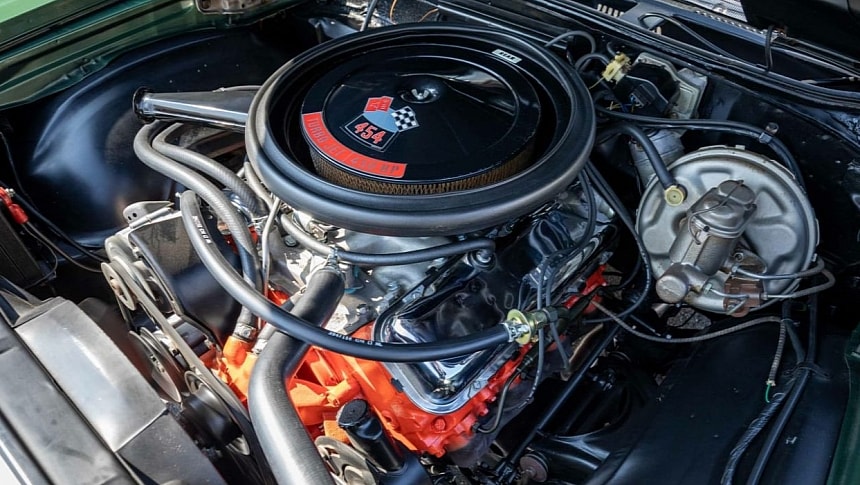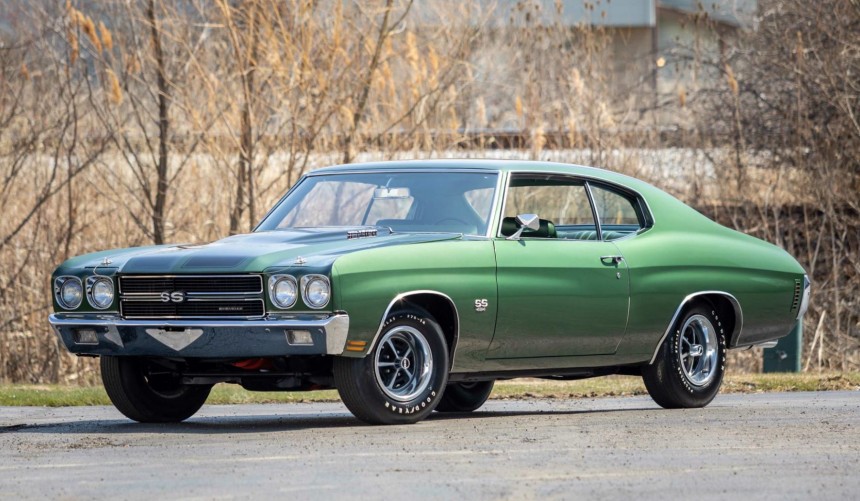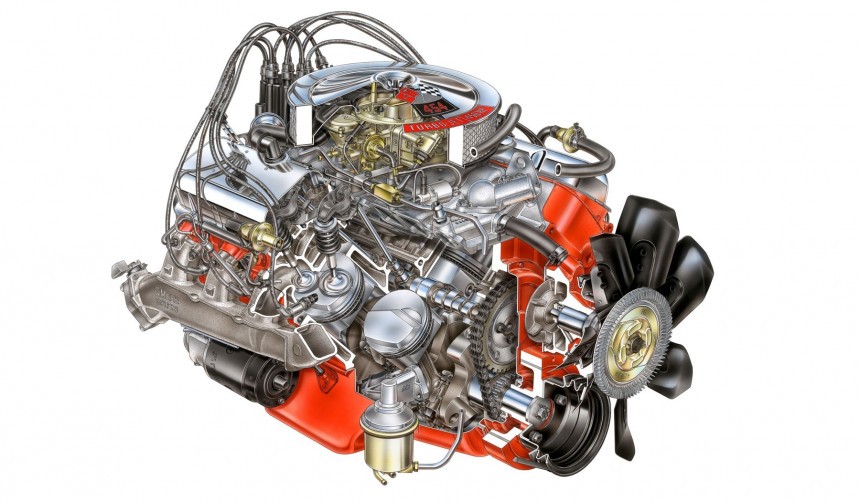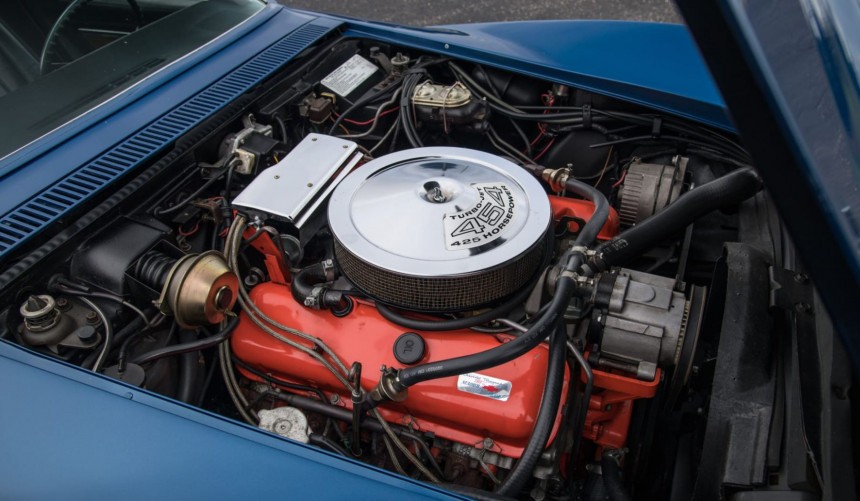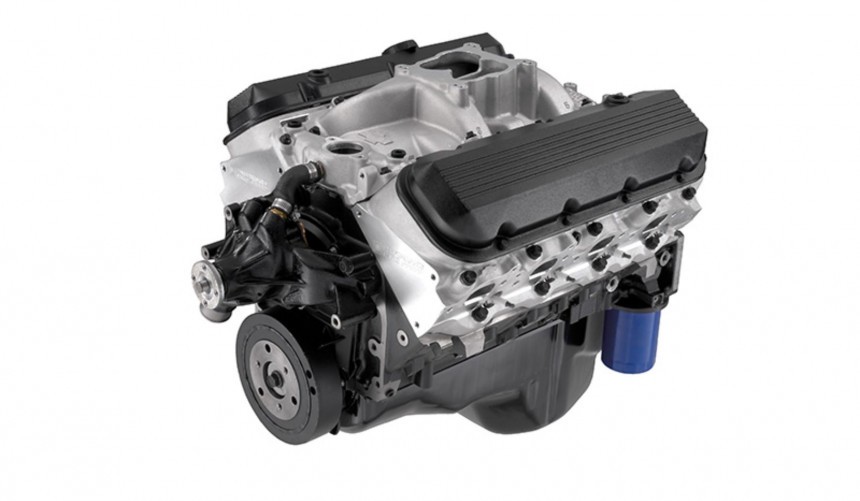Available in factory-built models for only two years, this iconic powerhouse is still the largest V8 ever fitted into a mass-produced Chevy passenger car.
The American car-buying public's appetite for faster, more powerful models led to more and more factory hot-rodded cars during the late fifties and early seventies.
At first, such cars were full-size models, but by the mid-sixties, manufacturers started to transplant powerful V8s from their land yachts into relatively smaller and lighter intermediates.
Chevrolet was one of the pioneers of what became the muscle car craze of the sixties and seventies.
The Bowtie brand's focus on factory-built performance started with the 1961 Impala SS and continued with the Chevelle Malibu SS Z16 four years later.
From that point on, Chevy made a habit of stuffing potent big blocks into the engine bays of intermediates and pony cars, creating some of the most legendary rides from the golden age of muscle cars.
However, while rival brands used the "no replacement for displacement" recipe to cook up V8s that exceeded 400 cubic inches (6.55 liters), Chevrolet was prohibited from going past that figure in their intermediate cars by parent company GM's internal policy.
Thankfully, GM finally dropped that self-imposed ban for the 1970 model year cars, thus allowing its brands to go big - literally.
Therefore, the corporation's high-performance intermediate offerings received new V8 engines that made them veritable HEMI-powered Mopar slayers.
In the Chevy camp, the Chevelle SS (and its El Camino sibling)
became arguably the most fearsome muscle car that money could buy that year, thanks to the addition of a new, optional 454-ci (7.4-liter) Mark IV.
The Mark IV big block went through a series of changes throughout the years. Available for the Chevelle and Corvette, it debuted with a displacement of 396 ci (6.5 liters) in 1965, but with engineers free to go past the 400-cube mark, the 1970 model year saw the introduction of bigger versions.
The standard Chevelle SS powerplant was still marketed as a 392, but it was updated and enlarged to 402 ci (6.58 liters).
The first optional engine was a more powerful 402, and then the next two options allowed potential customers to get one of two 454 versions.
While the LS5, with its 390 hp and 500 lb-ft (678 Nm), was a great high-performance engine, the ultimate 454 was the LS6.
Its cast-iron block with a bore and stroke of 4.2 inches by 4 inches (108 mm × 101.6 mm) and four-bolt mains was the same as that of the LS5.
However, the list of distinct upgrades received by the LS6 included a compression ratio bump to 11.25:1, upgraded rectangle-port heads with free-flowing ports, a hotter solid-lifter camshaft, forged aluminum pistons, and a better low-rise aluminum intake topped with a bigger 780-cfm Holley carb.
Though the torque rating was unchanged compared to the LS5, the long list of upgrades pushed max output to 450 hp.
This made the LS6-equipped Chevelle SS the most powerful high-performance intermediate that one could buy from a dealership in 1970. You can learn more about the iconic model in the video below by MuscleCarOfTheWeek.
Even more impressive, it marked the first time a factory-built Chevy had an engine option capable of more horses than any of the V8s offered for the Corvette.
More potent than the mighty 426 HEMI but also uncomplicated, reliable, and easy to maintain, the LS6 was, in more ways than one, the ultimate factory-built muscle car engine.
On the street (or drag strip), this engine enabled the Chevelle SS to sprint from 0 to 60 mph (97 kph) in 5.5 seconds and achieve low-13-second quarter-mile runs.
Unfortunately, like most great things, the LS6 didn't last. By 1971, the curtain was dropping on the muscle car, so Chevrolet removed this great engine from the Chevelle SS options list.
Still, it remained in production for one last year as the Corvette's top engine - albeit with 25 fewer horses than it delivered in 1970.
Available in factory-built Chevys for only two years, the LS6 arrived late at the muscle car party, yet nevertheless, it became a timeless legend.
Today, SS Chevelles and C3 Corvettes with an original LS6 under their hoods are some of the most sought-after American rides from the early seventies.
Sales records from that period haven't survived, but it's estimated that about 4,475 Chevelles (and El Caminos) left the factory with the LS6 in 1970.
Add to that around 190 '71 Corvettes equipped with the LS6, and you get the idea of how rare and expensive a matching-numbers example powered by this mighty engine is today.
After the LS6 was discontinued, the 454 continued to power various Chevy cars, trucks, and vans until the end of the 1990 model year.
However, none of those subsequent Mark IV versions ever came close to the performance figures of the LS6.
The only ones that did were the 454 HO and ZZ454, which are still in production today as performance crate engines. With an upgraded Gen VI-based architecture and modern tech, the HO makes 12 hp less (in stock form) than the 1970 LS6, while the stock ZZ spits out 469 hp, nineteen more than the original LS6.
More than five decades after it was discontinued, the LS6 is still the largest V8 ever fitted into a Chevy production car. More importantly, it remains a symbol of the golden age of muscle cars that will live on in the hearts and minds of V8 enthusiasts even after ICEs become extinct.
At first, such cars were full-size models, but by the mid-sixties, manufacturers started to transplant powerful V8s from their land yachts into relatively smaller and lighter intermediates.
Chevrolet was one of the pioneers of what became the muscle car craze of the sixties and seventies.
The Bowtie brand's focus on factory-built performance started with the 1961 Impala SS and continued with the Chevelle Malibu SS Z16 four years later.
From that point on, Chevy made a habit of stuffing potent big blocks into the engine bays of intermediates and pony cars, creating some of the most legendary rides from the golden age of muscle cars.
However, while rival brands used the "no replacement for displacement" recipe to cook up V8s that exceeded 400 cubic inches (6.55 liters), Chevrolet was prohibited from going past that figure in their intermediate cars by parent company GM's internal policy.
The ban finally gets lifted
Therefore, the corporation's high-performance intermediate offerings received new V8 engines that made them veritable HEMI-powered Mopar slayers.
In the Chevy camp, the Chevelle SS (and its El Camino sibling)
became arguably the most fearsome muscle car that money could buy that year, thanks to the addition of a new, optional 454-ci (7.4-liter) Mark IV.
The Mark IV big block went through a series of changes throughout the years. Available for the Chevelle and Corvette, it debuted with a displacement of 396 ci (6.5 liters) in 1965, but with engineers free to go past the 400-cube mark, the 1970 model year saw the introduction of bigger versions.
The standard Chevelle SS powerplant was still marketed as a 392, but it was updated and enlarged to 402 ci (6.58 liters).
The first optional engine was a more powerful 402, and then the next two options allowed potential customers to get one of two 454 versions.
While the LS5, with its 390 hp and 500 lb-ft (678 Nm), was a great high-performance engine, the ultimate 454 was the LS6.
The legendary LS6
However, the list of distinct upgrades received by the LS6 included a compression ratio bump to 11.25:1, upgraded rectangle-port heads with free-flowing ports, a hotter solid-lifter camshaft, forged aluminum pistons, and a better low-rise aluminum intake topped with a bigger 780-cfm Holley carb.
Though the torque rating was unchanged compared to the LS5, the long list of upgrades pushed max output to 450 hp.
This made the LS6-equipped Chevelle SS the most powerful high-performance intermediate that one could buy from a dealership in 1970. You can learn more about the iconic model in the video below by MuscleCarOfTheWeek.
Even more impressive, it marked the first time a factory-built Chevy had an engine option capable of more horses than any of the V8s offered for the Corvette.
More potent than the mighty 426 HEMI but also uncomplicated, reliable, and easy to maintain, the LS6 was, in more ways than one, the ultimate factory-built muscle car engine.
On the street (or drag strip), this engine enabled the Chevelle SS to sprint from 0 to 60 mph (97 kph) in 5.5 seconds and achieve low-13-second quarter-mile runs.
One plus one, then gone
Still, it remained in production for one last year as the Corvette's top engine - albeit with 25 fewer horses than it delivered in 1970.
Available in factory-built Chevys for only two years, the LS6 arrived late at the muscle car party, yet nevertheless, it became a timeless legend.
Today, SS Chevelles and C3 Corvettes with an original LS6 under their hoods are some of the most sought-after American rides from the early seventies.
Sales records from that period haven't survived, but it's estimated that about 4,475 Chevelles (and El Caminos) left the factory with the LS6 in 1970.
Add to that around 190 '71 Corvettes equipped with the LS6, and you get the idea of how rare and expensive a matching-numbers example powered by this mighty engine is today.
Though not in LS6 guise, the 454 lived a long and fruitful life
However, none of those subsequent Mark IV versions ever came close to the performance figures of the LS6.
The only ones that did were the 454 HO and ZZ454, which are still in production today as performance crate engines. With an upgraded Gen VI-based architecture and modern tech, the HO makes 12 hp less (in stock form) than the 1970 LS6, while the stock ZZ spits out 469 hp, nineteen more than the original LS6.
More than five decades after it was discontinued, the LS6 is still the largest V8 ever fitted into a Chevy production car. More importantly, it remains a symbol of the golden age of muscle cars that will live on in the hearts and minds of V8 enthusiasts even after ICEs become extinct.
